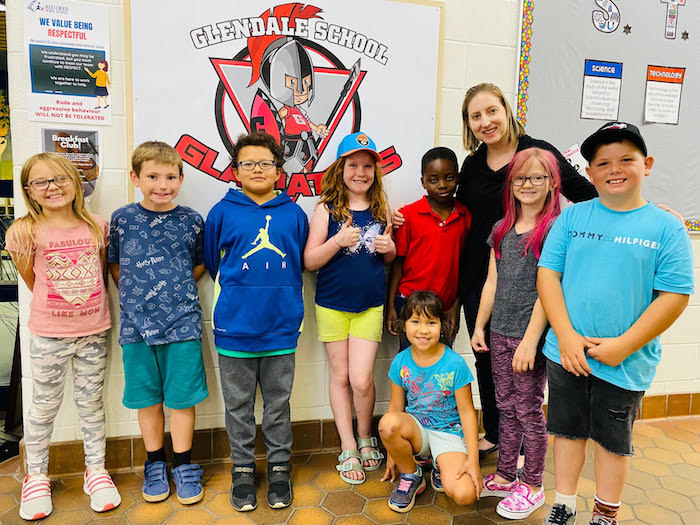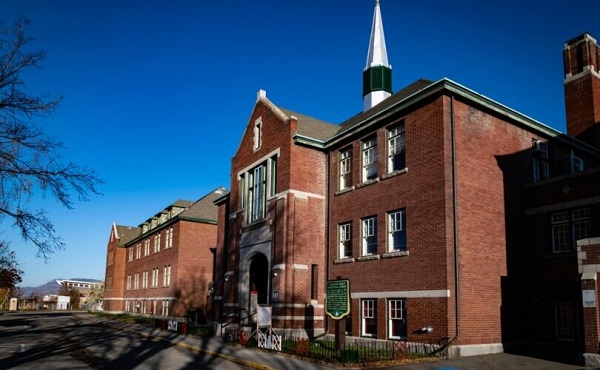Education
National awards for two teachers from Glendale Sciences and Technology School

Two teachers at Glendale Sciences and Technology School have been recognized at a national level for their excellence in teaching.
Ashton Lutz, Learning Facilitator, is one of 10 teachers across Canada to be awarded the 2022 Prime Minister’s Award for Teaching Excellence, while Amy Mathison, Grade 7/8 Math Teacher, is one of 25 teachers across Canada to be awarded the 2022 Certificate of Achievement for Teaching Excellence.
Both teachers were nominated by the school’s Principal Sandre Bevan, and Vice Principal Jeff Plackner.
“I feel very honoured and very grateful that I was nominated and selected for this award and that there is a belief in me by the people around me,” said Ashton, after learning she was a recipient. “I have a lot of gratitude and appreciation.”
In her new role as a Learning Facilitator, Ashton makes the connection between the Grade 2 curriculum and the daily lives of her students in order to fully engage each and every one of them. “What I really love about my role is that I get to connect with so many people and make a difference in so many lives,” she said. “When you come to school and a student has a great day, then you have a great day. I get to be a person in a child’s life that gets to make a true difference for them. It’s really rewarding.”
Amy added she also feels honoured to be recognized.

Amy Mathison (middle)
“I was not expecting this to happen. I was honoured to be nominated out of the many teachers in our Division, and then to receive the recognition feels amazing,” she said. “My parents are both teachers, so they were really proud.”
Both Ashton and Amy added they enjoy teaching at a school with a focus on Science, Technology, Engineering and Math (STEM).
“The role of science and technology is really important to engage learners and it’s really important that kids have that hands-on experience,” said Ashton. “With technology, I am able to pace instruction based on each student’s needs. For example, if a student is having trouble with a concept, they can get remediation at the same time that other students can move onto higher concepts.”
“The biggest thing about STEM learning is how engaged students are,” added Amy. “They are getting deeper learning with STEM. They get to do 3D printing and laser cutting – which are some pretty unique learning opportunities, and we have so much fun with it.”
Ashton’s interest in becoming a teacher stemmed from her time teaching swimming lessons. “I was taking college courses that didn’t allow me to teach swimming anymore and I really missed it,” she said. “I graduated with my combined Bachelor of Education and History degree from the University of Lethbridge in 2015 and moved to Red Deer, and I have been teaching elementary school ever since.”
For Amy, growing up in a household where both parents were teachers was inspiring. “At the dinner table they would always talk about teaching, and I started coaching sports when I was 16 and I loved it,” she said. “I went to school at the University of Lethbridge where I made the swim team and I was working on my degree in Kinesiology. A couple of years in, I applied to the Education program and got accepted. I completed a combined degree in Kinesiology and Education, and moved to Red Deer afterwards.”
Amy, who is in her ninth year of teaching, said she loves teaching in middle school. “I love the age of middle school kids – they are fun to teach, independent, and I appreciate their sense of humour,” she said. “I also love teaching at Glendale. We have some really great, supportive, and knowledgeable staff members. I enjoy the subjects and courses that I teach, as well as coaching volleyball here.”
Meanwhile, Ashton will fly to Ottawa next week to present with the other Teaching in Excellence Award recipients from across the country. “The presentation I have chosen is called Meeting Kids Where They Are At,” she said. “I have a true belief that everyone gets a seat at the table and it’s important that we meet their needs so they can be successful at school. So I’m going to be talking about what I feel my best practices are regarding that.”
Sandre added Glendale Sciences and Technology School is incredibly fortunate to have two phenomenal teachers.
“Our students, their parents, and our staff all benefit greatly from their respective efforts,” she said. “Ashton works hard to set students up for success in all aspects of their schooling. She has incredible insight about her students and works tirelessly to meet each of their individual needs. And Amy’s students truly believe that they can be successful in math, which is no easy task when a lot of people think that you are either good with numbers or you aren’t. We are so incredibly proud of them both.”
“The Board congratulates both Ashton and Amy on their national recognition,” said Board Chair Nicole Buchanan. “It is an honour for Red Deer Public to have dedicated and passionate teachers who go above and beyond every day for our students, ensuring there is excellence in teaching and learning in our classrooms.”
Ashton Lutz: Leadership in new learning
Certificate of Excellence Recipient

Glendale Sciences and Technology School
Grade 2, Language Arts, Math, Social Studies, Science, Art, P.E.
Amy Mathison: Leaving no child behind
Certificate of Achievement Recipient

Glendale Sciences and Technology School
Grade 7, Mathematics, Physical Education and Foods
Alberta
Alberta poll shows strong resistance to pornographic material in school libraries

From LifeSiteNews
A government survey revealed strong public support, particularly among parents, for restricting or banning sexually explicit books.
Albertans are largely opposed to their children viewing pornography in school libraries, according to government polling.
In a June 20 press release, the Government of Alberta announced that their public engagement survey, launched after the discovery of sexually explicit books in school libraries, found that Albertans strongly support removing or limiting such content.
“Parents, educators and Albertans in general want action to ensure children don’t have access to age-inappropriate materials in school libraries,” Demetrios Nicolaides, Minister of Education and Childcare, said.
“We will use this valuable input to guide the creation of a province-wide standard to ensure the policy reflects the priorities and values of Albertans,” he continued.
READ: Support for traditional family values surges in Alberta
The survey, conducted between May 28 to June 6, received nearly 80,000 responses, revealing a widespread interest in the issue.
While 61 percent of respondents said that they had never previously been concerned about children viewing sexually explicit content in libraries, most were opposed to young children viewing it. 34 percent said children should never be able to access sexually explicit content in school libraries, while 23 percent believed it should be restricted to those aged 15 and up.
Similarly, 44 percent of parents of school-aged children were supportive of government regulations to control content in school libraries. Additionally, 62 percent of respondents either agreed or strongly agreed that “parents and guardians should play a role in reporting or challenging the availability of materials with sexually explicit content in school libraries.”
READ: Alberta Conservatives seeking to ban sexually graphic books from school libraries
The polling results come after the Conservative Alberta government under Premier Danielle Smith announced that they are going ahead with plans to eventually ban books with sexually explicit as well as pornographic material, many of which contain LGBT and even pedophilic content, from all school libraries, on May 27.
At the time, Nicolaides revealed that it was “extremely concerning” to discover that sexually explicit books were available in school libraries.
The books in question, found at multiple school locations, are Gender Queer, a graphic novel by Maia Kobabe; Flamer, a graphic novel by Mike Curato; Blankets, a graphic novel by Craig Thompson; and Fun Home, a graphic novel by Alison Bechdel.
David Clinton
Why Are Ontario’s Public Schools So Violent?


 David Clinton
David Clinton
Ontario’s Auditor General just released a performance audit on the Toronto District School Board. I’m sure it’ll surprise exactly no one that “financial and capital resources are not consistently allocated in the most cost-effective or efficient way” or that “The effective management of operations was not always being measured and assessed for internal decision-making”.
And there was plenty of institutional chaos:
“Between 2017/18 and 2022/23…about 38% of TDSB schools did not report conducting the minimum number of fire drills required by the Ontario Fire Code annually, and about 31% of TDSB schools did not report conducting the minimum number of lockdown drills required by TDSB policy annually. The TDSB does not have an effective process to ensure the required number of drills are performed by each school, each year, or that they are performed in accordance with TDSB policy when performed.”
What else would you expect from a massive government bureaucracy that employs 40,000 people, spends $3.6 billion annually and – based on many of the highlighted items on their website – is laser-focused on pretty much anything besides education?
What you might not have seen coming was that around half of the report centered on in-school violence. To be sure, we’re told that there were only 407 violent events reported to the board during the 2022/2023 school year – which is a rate of around 17 events for every 10,000 students. 17:10,000 doesn’t exactly sound like an environment that’s spiraling out of control.
There was a caveat:
“Due to input errors by principals, the TDSB underreported the number of violent incidents that occurred between 2017/18 to 2021/22 to the Ministry by about 9%.”
Ok. But we’re still nowhere near Mad Max levels of violence. So what’s attracting so much of the auditor’s attention? Perhaps it’s got something to do with a couple of recent surveys whose results don’t quite match the board’s own records. Here’s how the audit describes the first of those:
“The 2022/23 TDSB Student and Parent Census was responded to by over 138,000 students, parents, guardians and caregivers. It showed that 23% of students in Grades 4 to 12 that responded to the survey said they were physically bullied (e.g., grabbed, shoved, punched, kicked, tripped, spat at), and about 71% stated they were verbally bullied (e.g., sworn at, threatened, insulted, teased, put down, called names, made fun of). Further, about 14% of student respondents indicated they had been cyberbullied. TDSB’s central tracking of all bullying incidents is much lower than this, suggesting that they are not centrally capturing a large number of bullying incidents that are occurring.”
“23% of students in Grades 4 to 12 that responded to the survey said they were physically bullied”. That’s not a great fit with that 17:10,000 ratio, even if you add the 9 percent of underreported incidents. And bear in mind that these students and their families were willing to discuss their experiences in a survey run by the school board itself, so it’s not like they’re hard to find.
But that’s not the worst of it. The Elementary Teachers’ Federation of Ontario (ETFO) ran their own survey in 2023. They wanted to hear about their members’ experiences with workplace violence. Here, quoting from the audit report, is what TDSB respondents told them:
- 42% had experienced physical force against themselves in 2022/23;
- 18% had experienced more than 10 of these physical force incidents in 2022/23;
- 81% indicated the number of violent incidents increased since they started working;
- about 77% responded that violence was a growing problem at their school;
- about 29% indicated they had suffered a physical injury;
- 57% had suffered a psychological injury/illness (such as mental stress, psychological or emotional harm) as a result of workplace violence against them; and
- about 85% indicated that violence at their school made teaching and working with students more difficult.
29 percent of teachers suffered a physical injury due to workplace violence. That’s elementary school teachers we’re talking about.
For perspective, even accounting for the 9 percent underreporting, the TDSB was aware of events impacting less than a quarter of a percentage point of their students (and apparently didn’t report any violence against teachers). But by their own accounts, 23 percent of all students and 42 percent of elementary teachers have suffered attacks. Are board officials willfully ignoring this stuff?
And if only there was some way to address violence and other criminal activities on school property. Perhaps – and I’m just spitballing here – there could even be people working in schools whose job it would be to (what’s the word I’m looking for?) police crime.
On a completely unrelated note, back in November, 2017, the Toronto District School Board voted 18-3 to permanently end their School Resource Officer (SRO) program. Since then, police officers have been unwelcome on board property.
To be sure, the TDSB has “accepted” all 18 of the report’s recommendations. But talk is cheap. Who’s to say that commitment won’t play out the same way we’ve seen with their fire drill compliance.
Can you spell “class action lawsuit”?
-

 COVID-1921 hours ago
COVID-1921 hours agoFDA requires new warning on mRNA COVID shots due to heart damage in young men
-

 Business19 hours ago
Business19 hours agoCarney’s new agenda faces old Canadian problems
-

 Daily Caller16 hours ago
Daily Caller16 hours agoBlackouts Coming If America Continues With Biden-Era Green Frenzy, Trump Admin Warns
-

 Indigenous20 hours ago
Indigenous20 hours agoInternal emails show Canadian gov’t doubted ‘mass graves’ narrative but went along with it
-

 Bruce Dowbiggin22 hours ago
Bruce Dowbiggin22 hours agoEau Canada! Join Us In An Inclusive New National Anthem
-

 Business2 days ago
Business2 days agoCBC six-figure salaries soar
-

 Addictions2 days ago
Addictions2 days agoCan addiction be predicted—and prevented?
-

 Addictions2 days ago
Addictions2 days agoMore young men want to restrict pornography: survey


